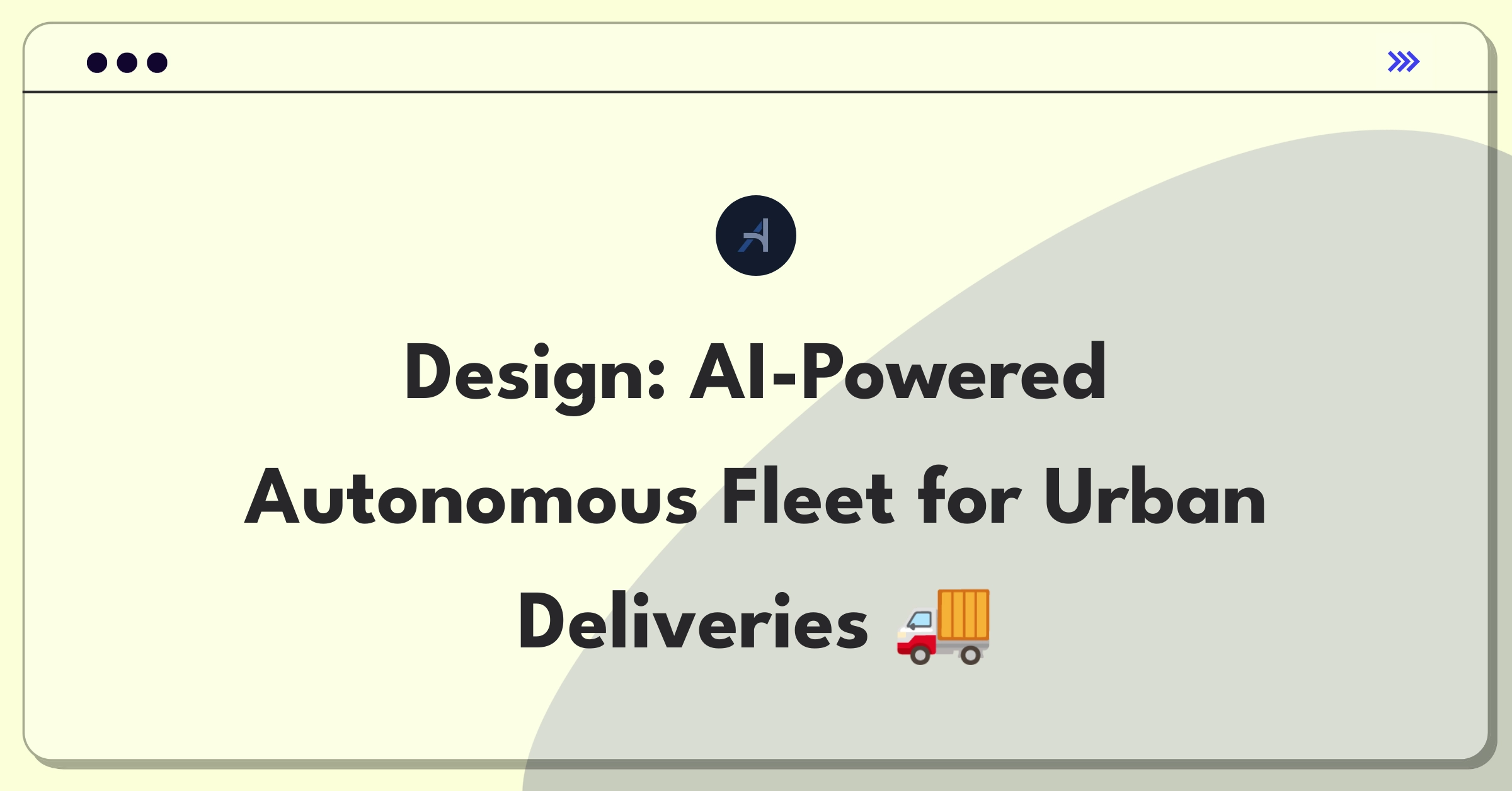Designing a Last-Mile Delivery Solution with Autonomous Vehicle Technology for TechLogistics
To design a last-mile delivery solution using autonomous vehicle technology, we'll focus on developing a scalable, AI-driven fleet management system integrated with robust route optimization algorithms, real-time tracking capabilities, and a secure IoT infrastructure for vehicle-to-infrastructure communication.
Introduction
The challenge of designing a last-mile delivery solution using autonomous vehicle technology presents a complex intersection of robotics, AI, logistics, and urban infrastructure. This task requires not only technical innovation but also careful consideration of regulatory landscapes, safety protocols, and seamless integration with existing delivery ecosystems. Our goal is to create a scalable, efficient, and safe autonomous delivery system that can revolutionize the last-mile logistics industry.
To address this challenge, I'll follow a structured approach:
- Clarify technical requirements and constraints
- Analyze the current state and technical challenges
- Propose technical solutions
- Outline an implementation roadmap
- Define metrics and monitoring strategies
- Assess and mitigate risks
- Develop a long-term technical strategy
Tip
Ensure that the autonomous delivery solution aligns with both technological capabilities and evolving urban mobility regulations.
Step 1
Clarify the Technical Requirements (3-4 minutes)
"Considering the complexity of autonomous systems, I'm assuming we're dealing with a mix of existing logistics infrastructure and new autonomous technologies. Could you provide insights into our current last-mile delivery capabilities and any autonomous vehicle pilots we've conducted?
Why it matters: Determines the baseline for integration and the level of autonomous technology readiness Expected answer: Limited autonomous vehicle testing in controlled environments, established traditional delivery infrastructure Impact on approach: Would need to design a phased rollout, starting with semi-autonomous features in controlled areas"
"Looking at the regulatory landscape, I imagine there are significant hurdles for fully autonomous vehicles in urban environments. What's our current understanding of the regulatory constraints we're facing in our target markets?
Why it matters: Shapes the technical approach to ensure compliance and safety Expected answer: Varied regulations across markets, with some allowing limited AV testing on public roads Impact on approach: May need to implement geofencing and remote operator capabilities to comply with different regulatory environments"
"Regarding the AI and machine learning aspects, what's our current capability in terms of route optimization, object detection, and decision-making algorithms for autonomous navigation?
Why it matters: Influences the core AI architecture and data requirements for the system Expected answer: Strong foundations in route optimization, developing capabilities in real-time object detection and decision-making Impact on approach: Focus on enhancing and integrating existing AI capabilities while developing new autonomous navigation features"
"From an infrastructure perspective, I'm curious about our IoT and edge computing capabilities. How robust is our current network for supporting real-time communication with a fleet of autonomous vehicles?
Why it matters: Determines the need for infrastructure upgrades and influences the overall system architecture Expected answer: Limited IoT infrastructure, primarily focused on tracking traditional delivery vehicles Impact on approach: Significant investment needed in edge computing and 5G integration for real-time autonomous vehicle control"
Tip
After clarifying these points, I'll proceed with the assumption that we have a solid foundation in logistics and route optimization, but limited experience with fully autonomous vehicles in real-world conditions. We'll need to focus on gradual autonomy implementation while building out the necessary infrastructure and AI capabilities.
Subscribe to access the full answer
Monthly Plan
The perfect plan for PMs who are in the final leg of their interview preparation
$99 /month
- Access to 8,000+ PM Questions
- 10 AI resume reviews credits
- Access to company guides
- Basic email support
- Access to community Q&A
Yearly Plan
The ultimate plan for aspiring PMs, SPMs and those preparing for big-tech
$99 $33 /month
- Everything in monthly plan
- Priority queue for AI resume review
- Monthly/Weekly newsletters
- Access to premium features
- Priority response to requested question


.png)